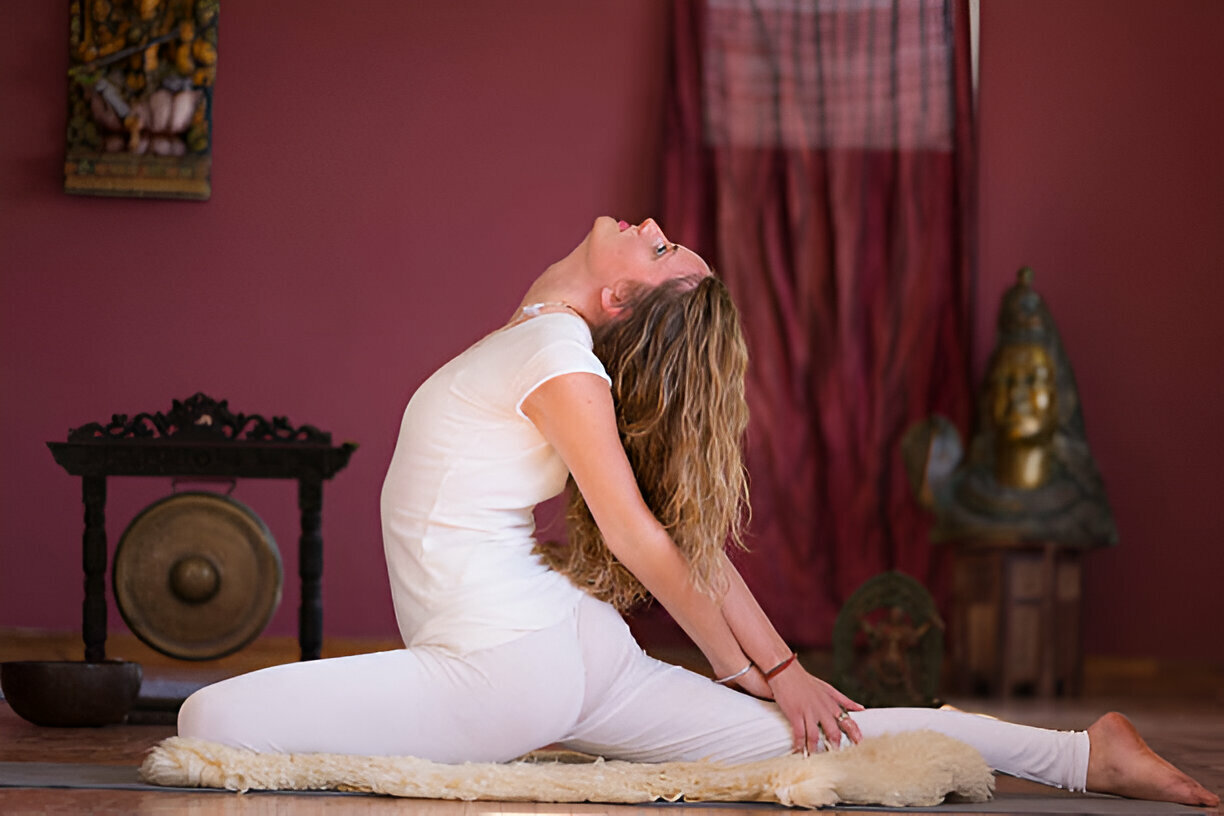Unlocking Strength: Pelvic Floor Yoga Practices for Core Stability

Pelvic floor yoga refers to specialized yoga practices that specifically target the muscles of the pelvic floor, which support the bladder, bowels, and in the case of women, the uterus. Often overlooked, these muscles play a crucial role in maintaining postural stability, continence, and sexual health. Pelvic floor yoga encompasses a series of exercises that aim to both strengthen and relax these muscles, promoting a balance that is vital for overall health and wellbeing.
Unlocking Strength: Pelvic Floor Yoga Practices for Core Stability offers a distinctive approach to fortifying the body’s foundation. By focusing on the pelvic floor, these practices can improve core strength, which is essential for a variety of everyday activities and athletic endeavors. The unique features of this approach include precise movements that are designed to increase awareness and control of the pelvic floor muscles, and in turn, help alleviate common issues such as lower back pain and improve pelvic organ function.
In the upcoming section, the discussion will illuminate how Pelvic Floor Yoga can be integrated into daily routines and how the practices can be modified to suit different fitness levels and health conditions. This will take into consideration contemporary lifestyles where sedentarism is prevalent, as well as the personal goals of individuals seeking to enhance their physical foundation and stability. The narrative will touch upon the subtleties that distinguish pelvic floor yoga from broader yoga practices, and the various techniques one can employ to achieve a stronger and more responsive pelvic floor.
Central to these practices is the synchronization of breathwork with movement, a hallmark of yoga that breathes life into the exercises specifically curated for the pelvic floor. With careful attention to the nuances of breath and movement, individuals can create an internal synergy that commands the muscles to operate with enhanced efficiency. This dialogue between breath and muscle not only enhances core stability but also encourages a mindful connection to the body’s internal landscape.
Moreover, the forthcoming content will address the physiological underpinnings that make Pelvic Floor Yoga an integral component of any fitness regimen aiming to foster core stability. From the biomechanics of pelvic alignment to the neural networks that govern muscular coordination, the segment aims to demystify the science while maintaining a narrative that is both captivating and informative for the reader seeking to harness the power of their pelvic floor.
- Pelvic floor yoga incorporates specific yoga poses that target the muscles of the pelvic floor, leading to improved core stability and overall strength.
- Engaging in pelvic floor yoga can enhance bladder control, support pelvic organ function, and relieve lower back pain by reinforcing the muscles that support these areas.
- Consistent practice of pelvic floor yoga may lead to better sexual health and improved recovery post-partum by increasing circulation and muscle tone within the pelvic region.
- The practice includes a variety of poses, such as Bridge Pose, Child’s Pose, and Deep Squat, which are tailored to gently strengthen the pelvic floor muscles.
- Proper breathing techniques are emphasized in pelvic floor yoga to ensure the maximum benefit from each pose and to help with the activation and relaxation of the pelvic floor muscles.
- Instructors of pelvic floor yoga often recommend that these poses be integrated into a regular yoga routine to maintain and enhance the health of the pelvic floor muscles over time.
- Pelvic floor yoga is suitable for individuals of all ages and is especially beneficial for women who are pregnant, postpartum, or experiencing menopause, as these life stages can affect pelvic floor strength.
- Individuals new to pelvic floor yoga are advised to begin with the guidance of a qualified yoga instructor to ensure poses are performed correctly to avoid strain or injury.
- Pelvic floor yoga may also incorporate props such as yoga blocks or straps to support and assist in the performance of poses, making them accessible to practitioners with varying levels of flexibility and strength.
- The practice of pelvic floor yoga is not only limited to women; men can also benefit from these exercises as they too have pelvic floor muscles that require strengthening and maintenance.
### How Can Pelvic Floor Yoga Enhance Your Core Stability?
Pelvic floor yoga is an integrative approach focusing not only on strengthening the pelvic floor muscles but also on enhancing overall core stability. By incorporating mindful breathing and targeted postures, pelvic floor yoga seeks to reinforce the foundation of the body’s center.
#### Understanding Key Terms in Pelvic Floor Yoga for Core Stability
The term `pelvic floor` refers to the layer of muscles stretching like a hammock across the pelvis, supporting the bladder, bowel, and in women, the uterus. `Core stability` is the strength and coordination of muscles in your abdomen, lower back, hips, and pelvis, which are crucial for balance and movement. `Yoga` is a practice that involves breath control, meditation, and the adoption of specific bodily postures for health and relaxation. Within this context, `pelvic floor yoga` comprises a series of exercises designed to strengthen weak pelvic muscles and relax those that are overly tense, contributing to a more stable and supportive core.
#### Background and Context of Pelvic Floor Yoga
The practice of yoga for the pelvic floor is steeped in the understanding that this region is the epicenter of many vital functions and stability for the human body. Often neglected in traditional workouts, the health of the pelvic floor can significantly affect a person’s well-being. Weakness or dysfunction in these muscles can lead to issues such as incontinence, reduced sexual function, and pelvic pain. Pelvic floor yoga emerges as a gentle yet effective way to engage and fortify this critical muscle group, offering benefits that extend beyond just physical strengthening to include improved posture, better balance, and enhanced body awareness. Engaging in pelvic floor yoga regularly can be especially beneficial following pregnancy, surgery, or those experiencing age-related changes that affect core stability. Through the targeted postures and breath work, practitioners can gain a renewed sense of control and empowerment over their core bodily functions.
Developing Core Stability Through Pilates
Pilates is a low-impact exercise methodology designed to improve physical strength, flexibility, and posture, and enhance mental awareness. One of its central principles is the strengthening of the core, which comprises the muscles of the abdomen, lower back, hips, and pelvis. Joseph Pilates, the founder, referred to the core as the “powerhouse” of the body. A strong core contributes to overall strength and stability, improves balance, and decreases the risk of injury. In a typical Pilates class, participants engage in a series of controlled, precise movements that target deep core muscles. These exercises often involve specialized equipment, such as the reformer, which uses springs and pulleys to provide resistance, or the cadillac, designed for more advanced stretch and strength maneuvers.
Functional Strength Training Strategies
Functional strength training is focused on building strength that is applicable to real-life movements and activities. Unlike traditional weight lifting, which often isolates specific muscles, functional training involves compound movements that integrate various muscle groups. It is about training the body to deal with everyday situations like carrying groceries or lifting a suitcase. It involves exercises that improve coordination, agility, and balance while simultaneously enhancing muscular strength. For example, the deadlift is a potent exercise within functional strength training. It simulates the natural motion of picking up objects from the ground, utilizing the core, glutes, hamstrings, and back muscles. Squatting, pushing, and pulling movements are also fundamental to functional training, as these patterns mimic daily activities.
High-Intensity Interval Training for Cardiovascular Health
High-Intensity Interval Training (HIIT) is a cardiovascular workout strategy alternating short periods of intense anaerobic exercise with less intense recovery periods. This form of interval training can improve both aerobic and anaerobic endurance and has been linked to improved heart health, increased metabolism, and accelerated fat loss. A standard HIIT session might consist of a warm-up period, followed by several cycles of high-intensity exercise (like sprinting or jump squats) for 30 seconds to a minute, interspersed with low-intensity exercises (like walking or light jogging) for recovery. The workout concludes with a cool-down period. HIIT workouts can be adapted for people of different fitness levels and can be performed with bodyweight exercises, free weights, or cardio equipment.
Nutritional Considerations for Muscle Recovery
Optimal nutrition plays a crucial role in muscle recovery and enhances the benefits of physical exercise. Post-exercise nutrition aims to replenish energy stores, repair muscle tissue, and promote muscle protein synthesis. Proteins, carbohydrates, and certain fats are essential macronutrients that assist in the muscle recovery process. Consuming protein sources like lean meats, dairy, legumes, or plant-based supplements helps provide the necessary amino acids for repairing and building muscle. Carbohydrates are equally important, as they restore glycogen levels in the muscles. Timely consumption of carbs, such as whole grains or fruits, post-workout can significantly improve recovery. Additionally, omega-3 fatty acids found in fish oil and flaxseeds may reduce muscular inflammation and aid in recuperation. Hydration is another pivotal aspect, with water assisting in transporting nutrients to muscles and helping eliminate metabolic waste.
Mindfulness and Stress Reduction Techniques
In today’s fast-paced world, managing stress is crucial for maintaining overall health and wellness. Mindfulness meditation has emerged as an effective method for reducing stress and improving emotional well-being. The practice involves intentional focus on the present moment while calmly acknowledging one’s thoughts, feelings, and bodily sensations. Mindfulness can be practiced through various techniques, such as focused breathing exercises, guided imagery, or body scans. By regularly engaging in mindfulness, individuals can develop a greater awareness of their mental patterns, leading to reduced levels of stress and anxiety. Moreover, mindfulness meditation has been shown to have potential benefits for sleep quality, concentration, and even chronic pain management.
What are pelvic floor yoga practices?
Pelvic floor yoga practices refer to a series of yoga poses and exercises that are specifically designed to strengthen the pelvic floor muscles. These muscles support the bladder, bowel, and, in women, the uterus, and play a crucial role in urinary and fecal continence, as well as sexual function. Strengthening these muscles can lead to better core stability and overall well-being.
Such practices often include focused breathing techniques, mindful movement, and poses that engage and relax the pelvic floor. Examples include Mula Bandha (root lock), bridge pose, and deep squatting postures. The integration of these poses helps to build strength and awareness in the pelvic region, which can aid in the prevention and treatment of issues such as incontinence and prolapse.
How does yoga improve core stability?
Yoga improves core stability by engaging multiple muscle groups that support the spine and pelvis during various poses and sequences. Core stability is not just about having strong abs; it’s about the coordinated working of muscles in the pelvic floor, back, hips, and abdomen. Yoga poses such as plank, boat pose, and twisting exercises activate these core muscles, promoting better posture and alignment.
Beyond strengthening, yoga emphasizes balance and functional flexibility. By practicing a variety of poses that challenge balance and range of motion, you train your core muscles to react and stabilize the body effectively under different physical conditions. This holistic approach to core stability can have profound benefits for overall movement and injury prevention.
What are the benefits of strengthening the pelvic floor muscles?
Strengthening the pelvic floor muscles has numerous benefits for both men and women. For women, particularly those who have given birth, strong pelvic floor muscles can help in the recovery process and reduce the risk of issues such as incontinence and pelvic organ prolapse. It also plays a role in sexual health, enhancing sensation and orgasmic potential.
For men, a strong pelvic floor can help improve urinary function and prevent conditions such as premature ejaculation. For both genders, robust pelvic floor muscles are essential for core stability, which contributes to better posture, reduced back pain, and more efficient movement in daily activities and sports.
Can pelvic floor yoga practices help with recovery after childbirth?
Yes, pelvic floor yoga practices can be extremely helpful in recovery after childbirth. Postpartum women often face issues such as weakened pelvic muscles, incontinence, or feelings of instability in the core region. Through mindful and gradual yoga practices, new mothers can rebuild strength in the pelvic floor muscles, restore function, and enhance stability in the core.
It’s important, however, for postpartum women to approach these practices with caution. Before starting any yoga or exercise regimen after childbirth, it is recommended to seek clearance from a healthcare provider, and consider working with a qualified yoga instructor who is experienced in postnatal yoga to ensure the exercises are being performed safely and effectively.
Are there any risks associated with pelvic floor yoga exercises?
As with any physical practice, there are some risks associated with pelvic floor yoga exercises, particularly if done improperly. Overworking the pelvic floor can lead to tension and hypertonicity, which can be as problematic as weakness in these muscles. It’s important to maintain balance, working on both strength and relaxation of the pelvic floor to avoid potential issues such as pelvic pain or dysfunction.
Individuals with pre-existing conditions or those who have had surgery in the pelvic area should proceed with caution and seek professional guidance before beginning pelvic floor yoga exercises. Always listen to your body and if any pain or discomfort arises, stop and consult a healthcare professional or a certified yoga instructor specialized in pelvic health.
What yoga poses are most effective for engaging the pelvic floor?
Several yoga poses are known to effectively engage the pelvic floor. The bridge pose activates the pelvic muscles as you lift your hips. Child’s pose can help in relaxation and awareness of the pelvic floor. Squats and deep lunging poses like the goddess pose open and strengthen the muscles in the pelvic region. Also, practices that incorporate Mula Bandha (root lock) can directly target pelvic floor engagement.
However, the effectiveness of each pose may vary from person to person based on individual body types and existing strength. It’s beneficial to try a range of poses and pay attention to those that give you a sense of engagement and lift in the pelvic area while maintaining comfort and proper breathing.
How often should one practice pelvic floor yoga to see results?
The frequency of pelvic floor yoga practice can vary depending on individual goals and starting points. Generally, consistency is key to seeing results. Incorporating pelvic floor exercises into a daily routine, even for just 10-15 minutes, can make a significant difference. As with any exercise regimen, the muscles need time to respond and build strength.
It’s also important to note that results may not be immediate, and patience is required. Depending on the individual, it might take several weeks or even months to notice improvements in pelvic floor strength and core stability. Consistent practice combined with proper technique and breathwork will ultimately lead to the best outcomes.
Is pelvic floor yoga suitable for both men and women?
Absolutely, pelvic floor yoga is suitable for both men and women. While often associated with women, particularly around pregnancy and postpartum, men also have pelvic floor muscles that play a vital role in their physical health. Strengthening the pelvic floor can provide benefits such as improved bladder control, sexual health, and core strength for individuals regardless of gender.
Men and women may have different areas of focus within their practices depending on their specific anatomical and health needs, but the fundamental practices of strengthening and relaxing the pelvic floor apply to both sexes. Inclusive yoga classes that address pelvic floor health can be beneficial for all adults seeking to improve their core stability and overall wellness.
Can pelvic floor yoga eliminate the need for surgical interventions?
While pelvic floor yoga can significantly improve pelvic floor strength and alleviate symptoms associated with weak pelvic floor muscles, such as incontinence, it may not completely eliminate the need for surgical interventions in more severe cases. These practices can be an effective non-surgical option that many healthcare providers recommend trying before considering surgery.
For some individuals, consistent and targeted pelvic floor yoga may reduce symptoms to a level where surgery is not necessary. However, others may still require medical or surgical interventions to fully address their conditions. It’s important to discuss with a healthcare provider to understand the best approach for your specific situation.
Do I need any special equipment for pelvic floor yoga exercises?
No special equipment is necessary for basic pelvic floor yoga exercises, making them accessible to anyone. Many poses and practices that target the pelvic floor can be done using just your body weight and a yoga mat for comfort. Additional props like yoga blocks or cushions can be utilized to support the body in certain poses or to modify exercises for individual needs.
While equipment isn’t essential, some individuals may choose to use pelvic floor exercisers or biofeedback devices to enhance their practice. These tools are not a requirement for effective pelvic floor yoga, but they may help some people become more aware of how to activate these muscles correctly. It’s always a good idea to start with foundational practices and only consider incorporating extra equipment if you feel it will support your journey toward greater pelvic floor strength and stability.
Final Thoughts
Embracing pelvic floor yoga is a transformative way to enhance core stability and overall well-being. The targeted practices within pelvic floor yoga specifically bolster the muscles that support the bladder, bowels, and sexual organs, resulting in a stronger, more resilient foundation for every movement. Throughout the article, we’ve explored various poses and sequences that serve to both strengthen and relax the pelvic floor, highlighting the balance necessary for optimal function and health. Breathwork, an often overlooked component, plays a crucial role in pelvic floor yoga, linking the physical postures to the calming and centering effects on the nervous system.
The holistic approach of pelvic floor yoga encompasses not only physical exercise but also an understanding of the body’s anatomy and the interconnectedness of the pelvic region with emotional and mental health. Regular practice can significantly improve postural alignment and contribute to alleviating common issues such as incontinence and pelvic pain, as well as enhance sexual health. It is clear that both men and women can reap significant benefits from incorporating pelvic floor yoga into their routines, unlocking the strength hidden within the core’s deepest layers. As with any fitness endeavor, consistency and proper guidance from a knowledgeable instructor are key to safely experiencing the profound benefits of pelvic floor yoga.






